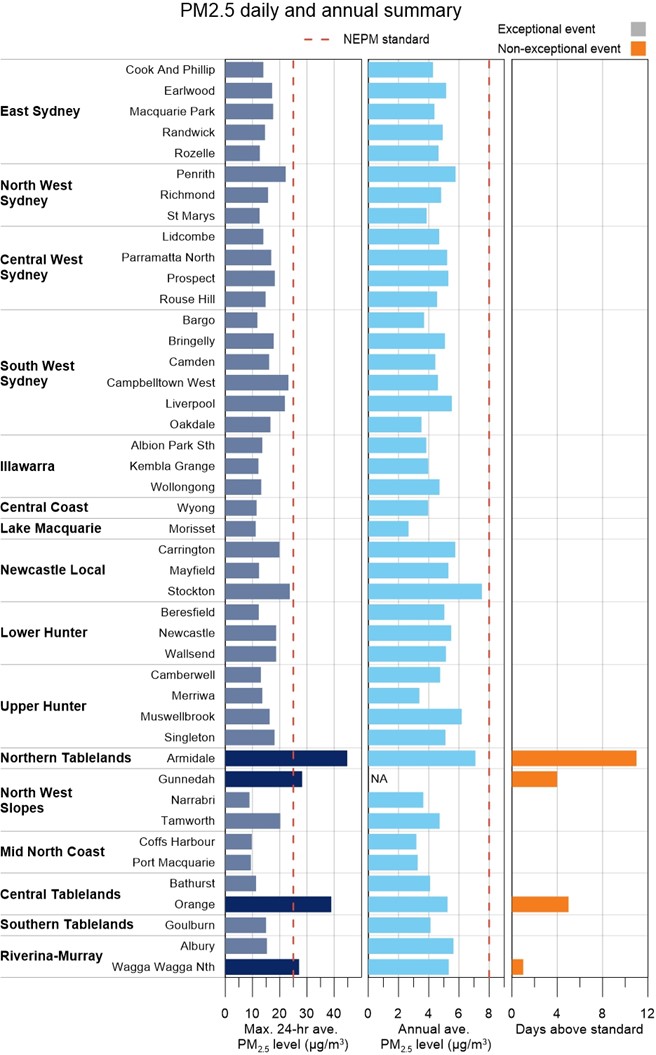Daily average PM2.5 levels were within the national standard 100% of the time in all but 4 regional centres in 2022. At Armidale, Gunnedah, Orange and Wagga Wagga, daily PM2.5 levels remained within the standard between 97% and 99.7% of the time.
National standards for PM2.5
- Annual average – 8 micrograms per cubic metre of air (8 µg/m3)
- Daily average – 25 micrograms per cubic metre of air (25 µg/m3)
Annual average PM2.5 levels
In 2022, all 43 monitoring stations in New South Wales with available annual average data recorded annual average PM2.5 levels within the national standard. In 2021 levels were recorded above the national standard at one station. This occurred at Stockton in the Newcastle local network with a level of 8.3 µg/m3.
Annual average PM2.5 levels in New South Wales in 2022 ranged from 2.7 µg/m3 at Morisset in Lake Macquarie to 7.5 µg/m3 at Stockton in the Newcastle local network. This compares with 3.1 µg/m3 recorded at Narrabri in the North West Slopes and 8.3 µg/m3 at Stockton in the Newcastle local network, for the lowest and highest annual averages, respectively, in 2021.
The Bradfield Highway roadside monitoring station (north of the Sydney Harbour Bridge, adjacent to one of the state's busiest roads) recorded an annual average PM2.5 level of 5.4 µg/m3.
Local industrial sources also affect particulate levels throughout the Hunter Valley. More information about particle levels in the Hunter regions can be found in Focus areas, on the Hunter Valley and Stockton pages.
Daily average PM2.5 levels
Daily average PM2.5 levels exceeded the national standard at one or more of the 44 stations in metropolitan or regional population centres on 16 days in 2022, compared with 23 days in 2021.
In 2022, 4 of the 44 monitoring stations recorded daily average PM2.5 levels over the national standard (see PM2.5 daily and annual summary graph). These stations included Armidale in the Northern Tablelands, Gunnedah in the Northwest Slopes, Orange in the Central Tablelands and Wagga Wagga North in the Riverina-Murray. All but one of these occurred due to smoke from domestic wood heaters. One day at Wagga Wagga North in the Riverina-Murray was affected by agricultural burning.
By comparison, in 2021, 23 monitoring stations recorded levels over the standard in the Sydney and Riverina-Murray regions. Of these, there were 19 stations in Sydney, and one each in the Central Tablelands, Southern Tablelands, Northern Tablelands and Riverina-Murray regions.
The maximum daily average PM2.5 level in 2022 was 44.8 µg/m3 recorded at Armidale in the Northern Tablelands on 20 June 2022. This level was recorded during cold, calm conditions in which smoke from domestic would heaters was trapped under a temperature inversion layer, which inhibits dispersion of pollutants.

Bar chart of PM2.5 measurements at 42 stations. It shows daily and annual averages, plus exceptional and non-exceptional event days.
PM2.5 daily and annual summary
Bar chart summary of PM2.5 measurements at the 42 stations in metropolitan or regional population centres measuring PM2.5, plus Camberwell small community and Merriwa background stations in the Upper Hunter. It shows for PM2.5, the maximum daily average, annual average and exceptional and non-exceptional event days. Exceedances of the daily and annual standards are shaded darker.
NA Annual average not reported (<75% of data available – PM10 data not available at Gunnedah from 26 July to 27 October 2022 due to an instrument fault).
Note: Days exceeding standard are divided into exceptional and non-exceptional events. Exceptional events are those related to bushfires, hazard reduction burns and continental-scale dust storms. These are not counted towards the National Environment Protection Measure (NEPM) goal of 'no days above [that is, exceeding] the particle standards in a year'.